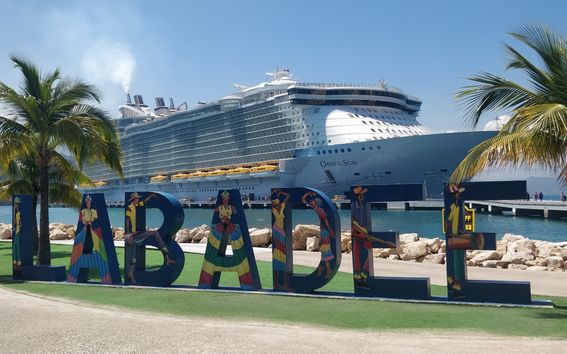Passion, expertise and collaboration are the keys to a successful cruise ship design

In her doctoral dissertation, recent Aalto University graduate Marjo Keiramo, D.Sc. (Tech.), studies the importance of the early conceptual design phases of cruise ship design and the key factors for creating a successful end product.
Designing a cruise ship is far from simple. A cruise ship is a future-facing product of high technology and the result of heavy development work. The conceptual design of a cruise ship is a complex process that contains many uncertain factors and numerous actors. The experiences of end users are at the core of this process. From a business perspective, a successful product remains attractive and competitive even decades into its life span.
Keiramo emphasises the identifying and sequencing of the processes that make up the early phase of design. 'Ship design consists of many phases. The beginning – conceptual design – is the most creative one. It forms the basis for the following design phases and the project in its entirety. This is why it is also important to be able to lead the experts of the creative phase and to steer the early-phase design in the right direction,' she says.
As part of her doctoral research, Keiramo developed a model for conceptual design that aims to unify technical and architectural design, the formation of a vessel's price as well as the assessment of various risks relevant for design and construction.
'Front-loading the design model improves the design process as a whole, while also accounting for the significance of design direction and management in large construction projects,' Keiramo notes.
Each ship represents the best compromise
Conceptual design includes many experts and participants from different fields. Experts participating in the design process must be able to maintain lines of communication between various teams and experts as well as forge compromises in order to reach an optimal result. Every thought and idea cannot fit in a single product.
'Shipowners tend to have a strong view of what a vessel should be like, but it is very important for the shipyard to introduce some of their own, research-based knowledge and expertise into the design, especially with regard to features that will be required in the future. A wealth of ideas is also needed in order to make individual features and the ship as a whole attractive to passengers.'
Ship design is often seen as a purely technical affair, but it also requires creativity that allows for new solutions to be found.
‘Naval architects and engineers are a part of the creative design process alongside architects and other experts, and they must be able to understand the other designers and to find technical ways of implementing ideas. Finland is especially rich in engineering skill and high-level technological expertise,' Keiramo says.
Factors for success
A successful design is the result of many factors. Having passion for the work is important. Ships are designed in short amounts of time, and it may happen that even a large design must be revised completely. Setbacks must not paralyse the process, and one should instead look beyond them to the possibilities that are available.
Collaborative and communications skills are brought to the fore when dealing with large, global teams of experts. Being part of a concept team requires the capability to work with different kinds of people.
The interview section of the doctoral dissertation highlights expertise and experience. The importance of transferring tacit knowledge is also mentioned.
'The ability to build a team inspires confidence among partners. Problems in a team's work must be tackled right away, as they can cause delays, which in turn increase costs. There is no room for error. In this field, the cost of a delay might not be measured in thousands of euros – it could be in the millions,' reminds Keiramo.
What does the future hold for cruises?
Cruise travel was showing marked growth when the COVID-19 pandemic hit. It is estimated that the growth will resume once the cruise business can begin operating again. A generational shift is taking place among cruise customers, however. Millennials – those born in the 1980s – and the generations after them form a growing base of customers whose values are not yet exactly known.
'The greatest challenge for ship design is to forecast future trends in order to keep the ships that are built today attractive even after 30–40 years. Newer ships are intended to stay in the market for much longer than the older ones were. Ship designers must tackle major issues, such as a how to build environmentally friendly and energy-efficient ships, and how to construct and refit ships cost-effectively and in line with sustainable development,' Keiramo says.
Marjo Keiramo has worked for two decades for Royal Caribbean Group, Baltic Yachts and the Meyer Turku shipyard. She is the fifth woman to complete a doctoral degree in the field of naval architecture and maritime engineering in Finland. Her doctoral dissertation, for which the public defence was held 9 April 2021, is the first doctoral dissertation dealing with the conceptual design of cruise ships. Keiramo's extensive experience is on display in the dissertation: in addition to detailing her research, it offers a lot of interesting general information on cruise ships and shipbuilding. The dissertation is being adapted into a maritime engineering textbook.
Link to the Doctoral dissertation https://aaltodoc.aalto.fi/handle/123456789/103020
- Published:
- Updated:
Read more news

Get to know us: Associate Professor Maria Sammalkorpi
Sammalkorpi received her doctorate from Helsinki University of Technology 2004. After her defence, she has worked as a researcher at the Universities of Princeton, Yale and Aalto.
Aalto computer scientists in ICML 2024
Computer scientists in ICML 2024
Getting bacteria into line
Physicists use magnetic fields to manipulate bacterial behaviour